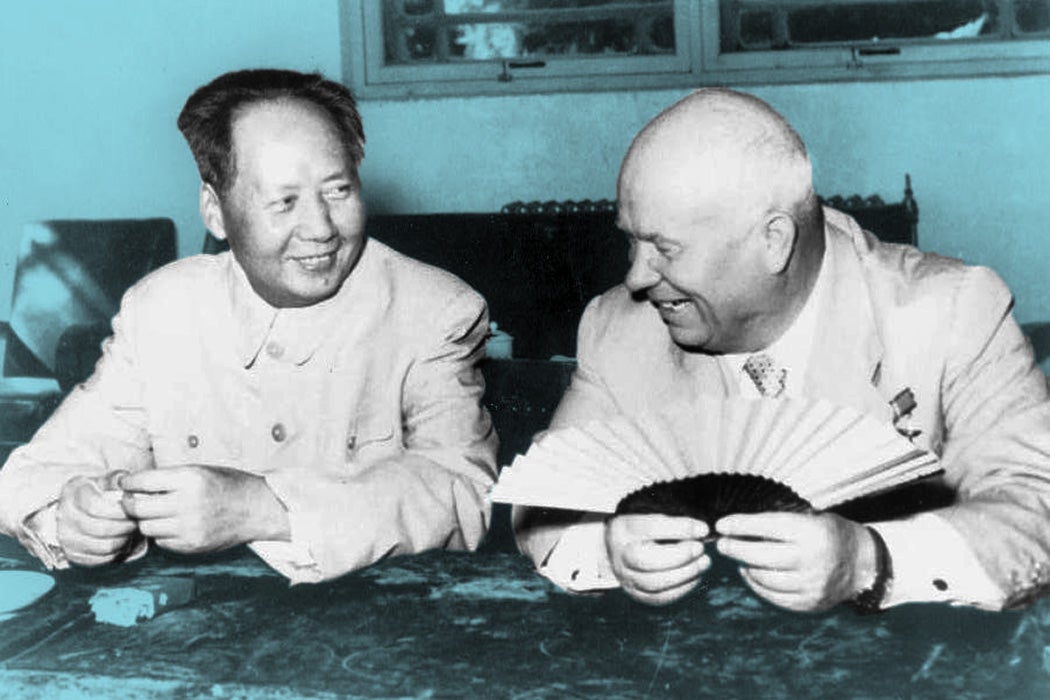Sixty years ago, the Cold War chessboard was suddenly rearranged. The Sino-Soviet Split shattered the idea of monolithic international communism. With the Communist Party of the Soviet Union (CPSU) and the Communist Party ofChina (CCP) at loggerheads, things got a lot more complicated. Ultimately, the stage was set for veteran Red-baiter Richard Nixon’s trip to China in 1972, a move designed to counter the USSR.
Ever since, Cold War scholars have been fascinated by the causes of the communist divorce. Danhui Li and Yafeng Xia write that historians have wondered whether the split was primarily “ideological cleavage, cultural differences, or a clash of national interests.”
Li and Xia argue that it was the struggle over the leadership of communism itself. “Only when a party had the authority to interpret Marxism could it be the legitimate leader of the movement,” they write. “The unwillingness of either China or the Soviet Union to compromise on the issue of leadership of the wider Communist movement precipitated the rupture.”
The Split had several antecedents but flamed into trouble with the Soviet-Albanian rupture at the 1960 Moscow conference of world communist parties. Albanians, upset with Nikita Khrushchev’s leadership of the USSR, allied with the Chinese and vice-versa. Soon enough, the Albanians and the Chinese were calling the CPSU’s new program—which was “effectively putting an end to domestic class struggle and the dictatorship of the proletariat”—nothing short of “revisionist.” “Revisionism” was an all-purpose criticism of party lines said to deviate from authentic Marxist-Leninism.
Things decayed from there. The CCP condemned the 22nd CPSU Congress in 1961. In the middle of 1962, Russians living in the Ili Kazak Autonomous Prefecture in China rioted and moved en masse across the border to the USSR, taking their money and goods with them. It was an economic blow to China. The border was militarized following this incident.
In October 1962, the combination of the Cuban Missile Crisis and the Sino-Indian War worsened the Sino-Soviet situation. China thought the USSR gave in too easily by removing missiles from Cuba. (Like most Americans, they weren’t informed that the US had also given in and removed missiles from Turkey). Meanwhile, in the Himalayas, Chinese and Indians fought over a contested border. The USSR, which had been sending military aid to India, initially sided with the Chinese, but then pulled back to neutrality. Talks over a nuclear test ban treaty also upset the Chinese, who were building their own nuclear weapons.
China’s domestic scene was a major factor in Chairman Mao’s policy. The economic situation was “catastrophic” in the wake of the disaster of his Great Leap Forward, in which tens of millions died from the resulting famine. Mao needed “militancy in foreign affairs” to distract from his Chinese-slaughtering domestic policies. Threats to him from within the CCP itself could be sidelined by charges of “rightist revisionism” and too-close alliance with the CPSU.
At 10th Plenary Session of the CCP’s 8th Central Committee Congress in 1962, First Premier Zhou Enlai said “Marxist truth and the center of of world revolution are shifting from Moscow to Beijing.” Internal CCP documents claimed “Only our Chairman Mao can develop Marxism-Leninism.”
Weekly Newsletter
Khrushchev, who denounced such rhetoric as “leftist opportunism, dogmatism and sectarianism,” fell from power in October 1964. But the CCP was convinced Khrushchev’s “line” of policy lived on.
In 1965, the Russians and Chinese irrevocably broke up over the best way of “assisting Vietnam and resisting the United States.” Both countries became convinced they had another major enemy besides the US. On “the enemy of my enemy” theory, the Chinese, having failed to take the leadership role in the socialist bloc, soon turned to the US for help against the USSR.
The two communist giants even clashed militarily in 1969 along their disputed border. All-out war was averted, but border issues wouldn’t be completely resolved until the early 2000s—by which time the USSR was no more and the Chinese were far from being Maoist revolutionaries.







